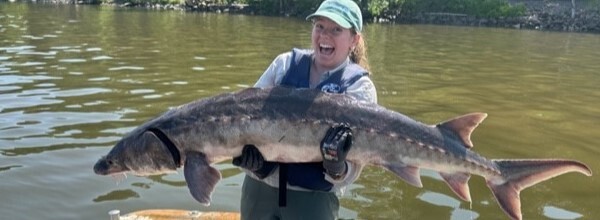Hudson River Atlantic Sturgeon: Studying the River's Largest Fish; Attend an Environmental Bond Act Listening Session
The New York State Department of Environmental Conservation sent this bulletin on 06/13/2023 10:00 AM EDT |
| DEC Delivers - Information to keep you connected and informed from the NYS Department of Environmental Conservation |
| Share or view as a web page || Update preferences or unsubscribe |
Hudson RiverNet
|
|
Each June, biologists from DEC’s Hudson River Fisheries Unit study the endangered adult Atlantic sturgeon when the fish return to the Hudson River to spawn. Atlantic sturgeon, the largest fish species in the Hudson River Estuary, are anadromous, which means they hatch in freshwater, spend most of their lives in saltwater, and return to freshwater to spawn. Atlantic sturgeon may live more than 60 years, reaching a weight of 800 pounds and a length of fourteen-feet. They are armored with bony plates, evidence of a lineage extending back to the age of dinosaurs. Sturgeon are bottom feeders, using whisker-like barbels on the underside of their snouts to find food - chiefly worms, insects, crustaceans, and small fish - that are sucked up in their tube-like mouths. The fisheries crew set nets to catch the sturgeon, carefully moving the fish from the nets into a large pen in the Hudson, tied to the boat. Crew members then weigh and measure each fish, determines its sex, and scan them for an electronic tag, called a PIT tag (Passive Integrated Transponder Data tag). If no tag is detected, a crew member inserts one into the base of the dorsal fin. The sturgeon are immediately released back into the Hudson River as soon as they are examined. PIT tags can be scanned to help learn more about sturgeon movement and behavior while in the Hudson, helping scientists learn what areas they use while in the river and how often they spawn. The tags also can be scanned and detected by other scientists in other rivers along the East Coast. Atlantic sturgeon migrate as far south as Georgia and as far north as Canada's Bay of Fundy, so the tags give scientists clues about where sturgeon migrate from place to place. The Hudson River currently supports the largest population of Atlantic sturgeon along the Atlantic Coast, estimated to be approximately 1,000 fish. Find out what it's like to go out with the fisheries crew while they work to study Atlantic sturgeon by watching DEC's Facebook Live post from the Hudson River on June 2nd. The fish are collected under National Marine Fisheries Service (NMFS) permit #20340.
Attend an Environmental Bond Act Listening SessionOverwhelmingly approved by voters last fall, the $4.2 billion Clean Water, Clean Air, and Green Jobs Environmental Bond Act prioritizes investments in environmental justice, climate change mitigation, shoreline restoration, flood resilience, water quality, open space conservation, recreational resources, and green jobs. This spring and summer, the public and potential funding applicants will be able to learn more about the Bond Act at a series of educational listening sessions. Sessions have been announced across the state:
Sessions will feature a presentation on the Bond Act and an opportunity for one-on-one discussion with State experts. Meetings will be open to the public. To register for these sessions, visit the Clean Water, Clean Air, and Green Jobs Environmental Bond Act webpage. State agencies, local governments, and partners will be able to access Environmental Bond Act funding over a multi-year process. Recognizing that vulnerable populations are disproportionately affected by negative environmental and climate change impacts, at least 35%, with a goal of 40%, of Bond Act benefits will be directed toward disadvantaged communities. |


